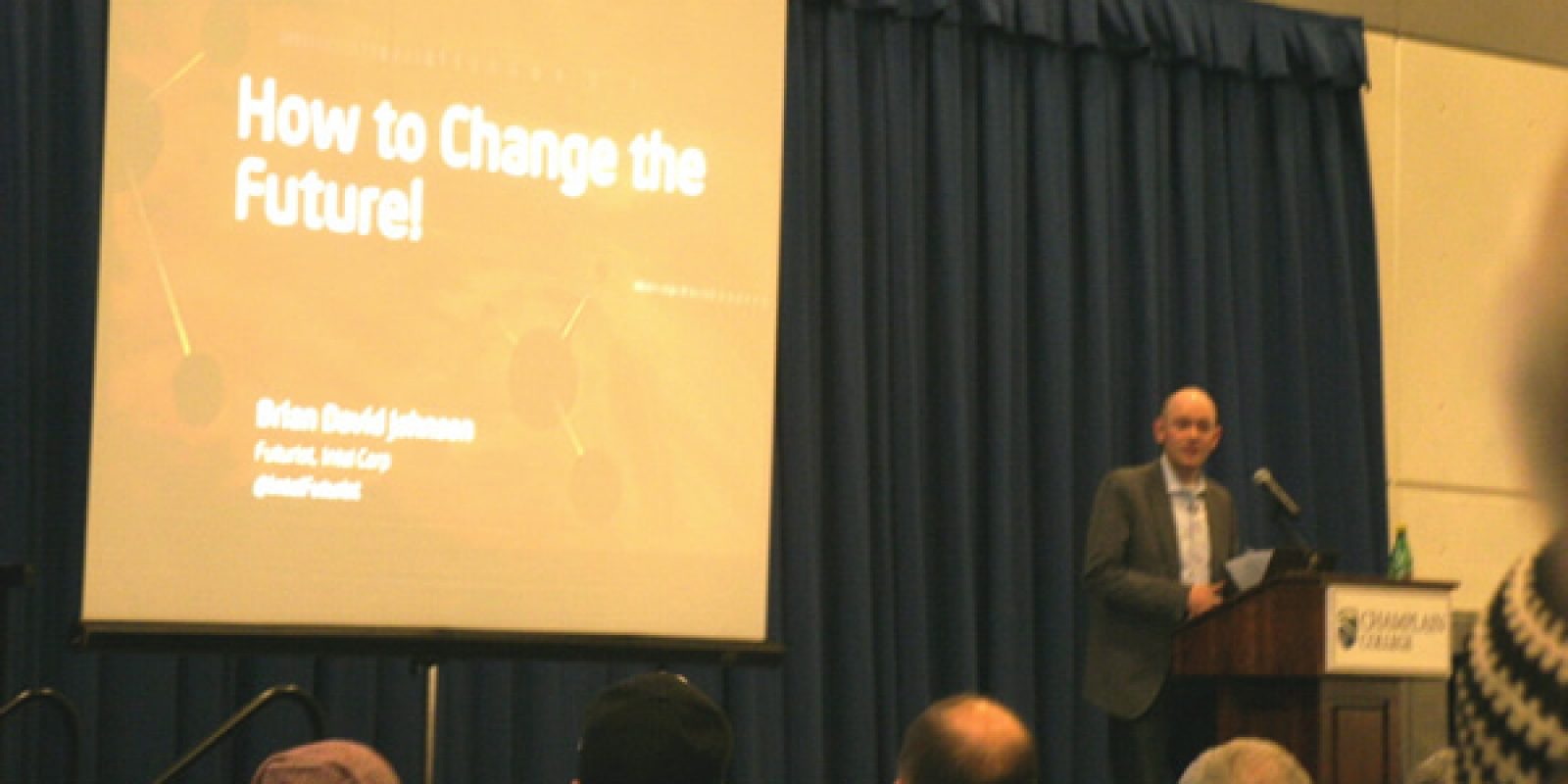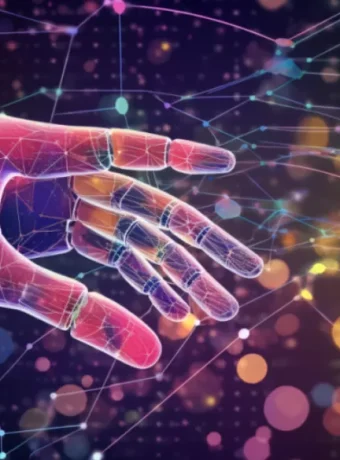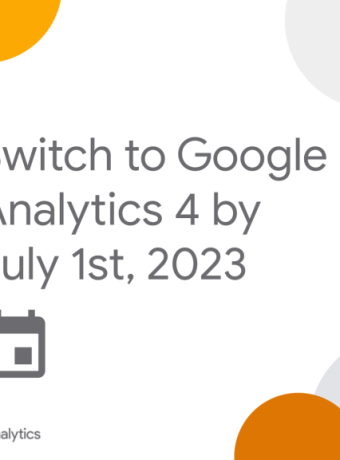Brian David Johnson (@IntelFuturist) describes his job as Futurist at Intel as telling the company what people will be doing 10-15 years into the future so that they can plan the technology now. Below are some notes Heavenly and I took from the lecture:
Johnson said he “Wants to design things that embrace the complexities of who we are”
Futurecasting
- It’s not about predicting the future.
- Developing an actionable vision for the future that we can build.
- Understanding what people want to do in the future.
- Using the process to figure out what is necessary to get there.
2020 Compute Moves to Zero
- Computer chips are getting smaller and more powerful
- Screens disappear, meaning computing will be all around us in everything we do and the screens we do use are there for us to interact with computing.
Big Data can be Used for Good or Bad – what do you want to do with it?
- We spew tons of data that is going into the cloud through our daily lives on social media and other online activities.
- We are exhaust pipes of data, which will have a secret life of its own, but its meaningless until it touches the lives of people – the human impact, helping real people
- Our charge is to find ways to use the data to make lives better.
- The Human Impact of computing is the most important thing.
The World is Split into Two Groups
- You tell a person that one day chips will be in their bodies and you get two responses.
- One part is freaked out.
- The other says “sign me up!”
Fight, Flight, or Freeze
- Fear makes you stupid.
- Fears are usually cultural rather than technological.
- Time magazine poll things you should be afraid of, and what you shouldn’t be afraid of. No 1 was sharks, 2 airlines… should be afraid of heart disease which is most likely to kill you.
The thing holding us back is our imagination
- Science and technology have progressed to the point where what we build is only constrained by the limits of our imaginations.
- The future is not some distant thing that will eventually happen to us – the future is being built everyday by people.
- Imagine a far more awesome future than what we should have now.
- What is the future you want and what is the future you want to avoid?
- The tomorrow project: think about the future and share it with somebody.
How Do We Change the Future?
- At Intel – try to impact the lives of everyone on the planet.
- Change the story people tell themselves about the future they will live in.
- Talk to people about what you want for the future and what they want and the future will most likely meet somewhere in the middle.
- Meaningfully touch the lives of everyone on the planet and make it better.
- If future is built everyday by actions of people, what does that tell us?
- Change the story people tell themselves about the future they will live in.
- Challenge to you – have a vision for the future and do something about it, you can’t sit back. Strive to make the lives of people better.
- You must decide what future you want and what you will do about it.
- Set the bar high enough to improve the lives of everyone – that should be the goal.
Q&A
Question: Which of Windows, Apple and Linux will win?
Answer: All of the above. Choice always wins. Always bet on choice and as much variety as possible
Question: What makes technology successful?
Answer: Are you making people’s lives better? If it solves a problem it will succeed. Any new tech should solve a problem – improve life. Blending the physical and digital. I am a farm futurist (for a mag). Farmers are the geekiest of geeks. Best review of Google Glass from a farmer: “like a smartphone on your face” Farmers are very busy and don’t have time for anything not useful, they are the best at figuring out how to get stuff done.
Question: Tesla cutting out middleman, thoughts?
Answer: The internet has reduced the need for many middlemen such as travel agents. They still exist, but not as much. To succeed you will need to provide more value than the direct/ internet counterparts.
Question: Healthcare market future?
Answer: New devices, smaller devices than smart phone can be used with healthcare. New devices will help with preventable healthcare.
Question: How to become a futurist?
Answer: His job came from the energy industry, make yourself redundant. Look at places at need to make big bets, energy, high tech, pharma, government. His job is also called strategic forecasting.
Question: Idea translation, any tips to communicate ideas that are hard to describe?
Answer: SciFi, we relate through narratives. Put it into context or narratives. Example: person place and problem. Be able to know the smell of the future, and as bonus know what it tastes like.
Question: What kind of future imagine with resource scarcity?
Answer: We do look at resources while taking future into account, a big part of the modeling they do.
Question: AI, will it catch up with human intelligence?
Answer: Not sold on idea that it will. Thought he would ask about terminators – as that is telling of humans, but we must take responsibility for it. The Technological Singularity is when machine intelligence surpasses human intelligence. What kind of intelligence do we want and what do we want them to do for us? Good futures and bad ones, steps to good? To have a good future we need to have a vision – based on facts rather than fears. Have conversations with people.
Question: Economics dying? Alchemy?
Answer: Favorite economist is Paul Thomas, talks about how GDP, is flawed. Human beings are value based systems, and data driven. How you look at the market? What are you optimizing for? We should question how we look at economic metrics/values.
Question: Insight to 3d printing and 3d printing stores?
Answer: Over time with technology we are able to do more in our own home, but there still remains a need for a stores to do some of the work for us like with desktop printing. We print stuff at home, but still use print shops for some tasks or buy greeting cards instead of printing them at home or we buy books at a bookstore instead of reading them on a computer. Working on an open source robot that will be freely available to download and print through a 3d printer. Open source robots should be like a smart phone with legs. Freely available with the ability to download various apps into them to make them do whatever you want.

Final thoughts:
Students are unencumbered by the past, they would be the 1st gen of not knowing what it is like without internet.
It’s your responsibility to go to past generations to discuss the future.
The video below WAS NOT from this lecture but from a Keynote Presentation he did for ASTC in 2012:



